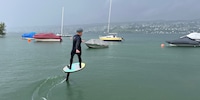
Background information
Indiana CEO: «foiling is the perfect mix of fitness and adrenaline»
by Siri Schubert
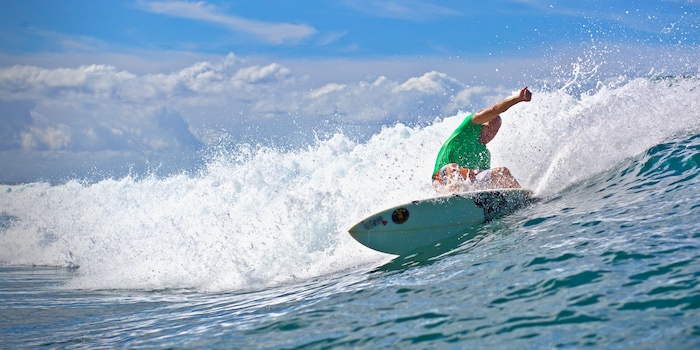
Mike Jucker has been observing the most important trends in surfing, SUP (stand-up paddling) and foiling in Hawaii for two decades now. He wanted to share his passion for skateboarding and waves, so he founded a longboard brand and the magazine Stand-Up.
Mike Jucker lives on the Hawaiian island of Maui and is the founder of the skateboard brand Jucker Hawaii. As publisher of Stand-Up-Magazine, he reports on the latest global trends in water sports. At the 2024 boat show in Düsseldorf, we sat down for an interview about emigrating, the dream of surfing and the latest developments in paddling and foiling.
What took you from Switzerland to Hawaii?
Mike Jucker: I’ve lived in Maui for 22 years. I left Switzerland because I wanted to fulfil my dreams of living somewhere where it’s summer everyday and I can always go surfing. In my younger years, when I was around 20 years old, I let myself float around the world. Until I met my future wife in Oahu.
Did you stay there then?
No, it’s not that simple to get a residence and work permit. We had a long-distance relationship for several years and then met again in Hawaii in 2002 and got married quite spontaneously. Everything we owned back then practically fitted into our travel bags. We’ve lived in Maui for 22 years now and have built a life here. And have three children who also love the waves, surfing and the sea.
Where did your love of water sports come from?
It all started with my love of board sports. I grew up in Zurich in the skateboard scene and in the mountains in the snowboard scene. Board sports have always fascinated me, but what really got me excited were the blue tropical waves of Hawaii, Indonesia, Australia, Fiji.
Can you explain the fascination of waves?
Surfing was practically «the last frontier» for me, the ultimate board sport. And I wanted to conquer the waves because it gave me the best feeling. When I was a teenager, I thought all those surfer dudes surfing the craziest waves just in their boardshorts were really cool. I wanted to do it, too. And I was drawn to the beach culture I saw my cousins had in South Africa. It was just too cramped and cold for me in Switzerland. With my board under my arm, I had to see how I could get away.
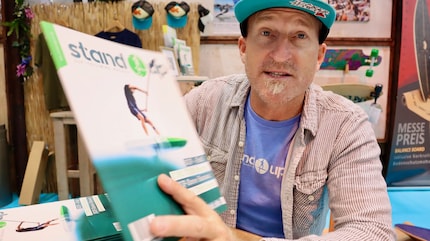
What happened next?
Of course there’s always a reality check when you follow your dreams. That meant I first had to find a job. I then started a career in the hotel business in Maui.
But that wasn’t all, because you stayed loyal to the board sports.
Around 2007, a friend and I came up with the idea to start a website where we’d sell surf products. We wanted to offer really cool Hawaiian labels and export them to Germany. In 2008, first the US economy and then the global economy collapsed and our idea was on the verge of decline. But then we had the opportunity to produce longboards in Germany. We were the first to offer boards like these in the mid-price range. And that was the starting point for our company, Jucker Hawaii. In 2010, things really took off.
You’re not just an expert in skateboarding and longboarding, you’re also an expert in stand-up paddling. How did this come about?
2010 was actually a game-changing year. In Europe, SUP was still mostly unknown, but in Switzerland and Germany, the first races and events were starting. Back then, there wasn’t a single website which reported on this new sport and trends. I was practically sitting at the source and the eyes of the stand-up world were on Hawaii. And on the pioneers of the sport, Laird Hamilton, Dave Kalama and Robby Naish.
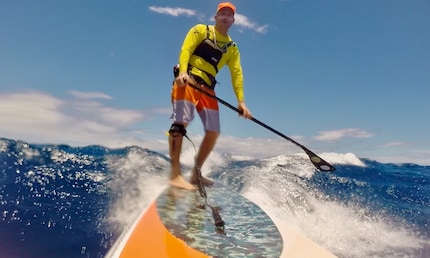
We got to know each other a little later in Hawaii, at my first Molokai2Oahu race in 2014.
Yes, that’s when things really took off and the sport boomed. But I’d already decided to publish not only a website, but also a print magazine. I have a passion for beautiful magazines, for good photography and for lifestyle stories that I wanted to see in print. In 2011, I sent the first magazine to Paddle Expo practically as an experiment to see how it would be received by the industry. The short answer – it went well. Now we’re sitting here 13 years later, talking about it.
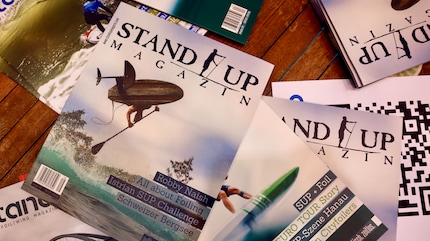
What makes the magazine so unique?
Since I live in Maui, I was there right from the start. Legends such as Kai Lenny and Connor Baxter were still teenagers back then. As a racer myself, I was also taking part in many races. It’s important to me that I practice the thing I’m talking about. In the surfing scene, it’s also a matter of respect that I’m not just stood at the shoreline watching what’s happening on the water, but actually doing it myself.
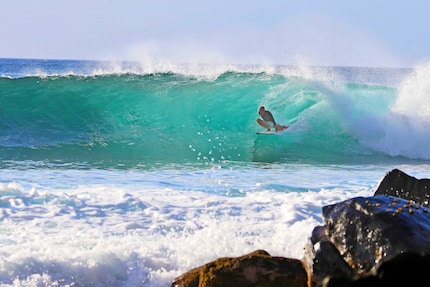
In the meantime, however, the sport has evolved.
Definitely. The concept of stand-up paddling came about from surfing. That’s why we had the development of downwind paddling here in Hawaii, where paddlers surf the wind waves over long distances. Flat water paddling became very popular in Europe and that’s how various scenes developed. There was and still is an active racing scene in Europe. Nevertheless, popular and recreational sport has developed more strongly in Europe.
But things looked different in Hawaii.
Of course. Athletes such as Kai Lenny, who does incredible things on all kinds of boards in the big waves, soon found it too boring to paddle the traditional route in Maui, the Maliko Run, on a long 14-foot board. So the idea came up to screw a wing, i.e. a foil, under the board, as has become the trend in kitesurfing and windsurfing. And it worked better than expected.
But it didn’t stop at downwind foiling?
Basically everyone here is a surfer and when it comes to speed and adrenaline, they’re there. So foiling was quickly adapted for the wave. And the whole thing was so new that the stand-up boards disappeared into the garages. Stand-up paddling was practically extinct in Hawaii. And then the wings came along. A wing enabled you to harness the power of the wind. This has given the sport another huge boost.
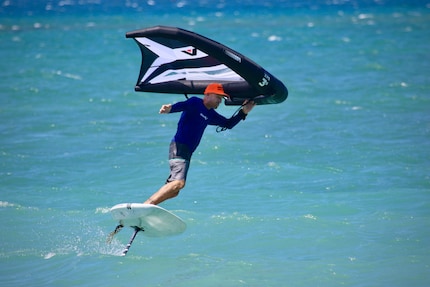
How is the sport continuing to develop?
At the moment, it’s changing rapidly. I followed all of it with the stand-up magazine, so that we also became a foil and wing magazine to a certain extent. The technology is now so good that foils under a SUP are also becoming very efficient because they allow you to float over the sea on the hydrofoil with the force from the paddle. And in Europe, you see more and more people pumping the board on the wing using their leg power. That’s fine when you don’t have 30 knot winds.
In the second part of your video, you can see the different types of foiling.
Will foiling replace stand-up paddling?
I doubt it. Paddlers who are looking for action and are enthusiastic about downwind paddling and SUP surfing may want to switch. But those who use the SUP purely for leisure and are perhaps not that sporty will be less likely to start foiling, as it’s not that easy to learn. And those SUP racers who specialise in racing are sticking with it, as we can already see at the big races. Just like in other sports, there will be various disciplines that exist alongside each other. And there is certainly a lot more to come in the future.
Thanks, Mike for the chat and the exciting insights into the world of water sports.
Research diver, outdoor guide and SUP instructor – I love being in, on and around water. Lakes, rivers and the ocean are my playgrounds. For a change of perspective, I look at the world from above while trail running or flying drones.
Interesting facts about products, behind-the-scenes looks at manufacturers and deep-dives on interesting people.
Show all